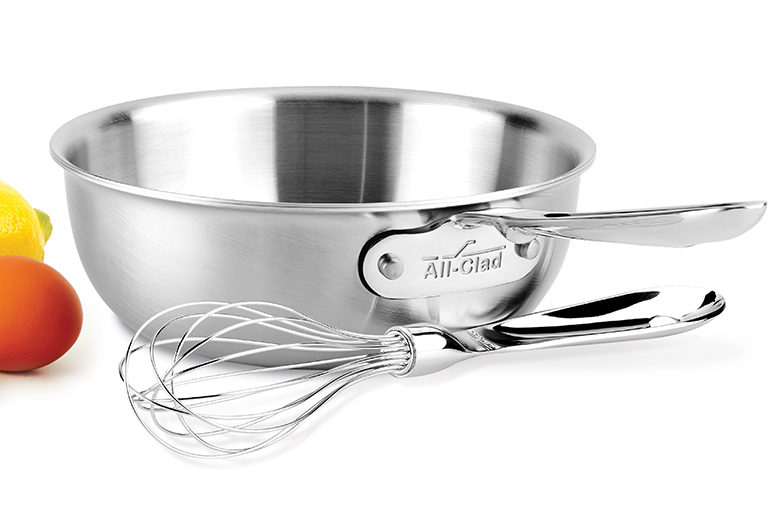
Product reviewed: All-Clad Stainless Steel 2 Qt. Saucier with Whisk
Put on your best French accent to pronounce saucier as “soh-see-ay,” a pan used in classic French cooking. French kitchen brigades include a saucier chef like Linguini, the character in “Ratatouille”, who makes soups, stocks and sauces. My French culinary training included daily sauce-making, but at home, my saucier pans do much more. Testing the All-Clad upgraded 2-quart saucier reminded me why mine are banged up, but treasured.
Made in the U.S., this saucier includes a whisk and limited lifetime warranty. It’s warp-resistant, dishwasher-friendly, induction capable and oven-safe up to 500 degrees. The pan is designated fully clad due to different layers of bonded metal. Its thick aluminum core is surrounded by stainless steel for fast heat conductivity and even heating.
Saucier pans have curved sides and rounded bases that invite stirring thick sauces like béchamel, a base for white lasagna, mac ’n cheese mornay sauce or classic gratins. Without any straight-edged corners at the base, whisks and spoons can easily prevent flour sticking to corners to burn or dislodge later as uncooked bits that clump your sauces or compromise custards, pastry cream and pâte à choux.
I made a mustard béchamel sauce for an asparagus gratin and appreciated the practical pouring-lip rim, an upgrade from my old saucier. The saucier handle stayed cool due to cast-stainless steel and is well balanced with an angle mostly parallel to the pot for good leverage. However, the whisk’s top-heavy handle tended to tip out of the pan.
The wide mouth encourages evaporation for sauce reduction and faster cooking. Tests by Cook’s Illustrated confirm sauciers noticeably evaporate liquids more quickly than saucepans. A lidless saucier works well for reducing dishes and sauces to concentrate flavor ![]() and thicken for delicious curries, demi-glace sauces, chutneys and gravy.
and thicken for delicious curries, demi-glace sauces, chutneys and gravy.
Unlike typical 2-quart sauce pans or soup pots, this saucier’s curvy base and wider mouth means it’s easier to clean with less depth and no corners; however, the depth limits cooking foods that steam or splatter such as a bubbly oatmeal. I cooked a 12-ounce bag of whole cranberries to make a holiday chutney, but hot juice spit from popping berries escaped from the shallow pan. A 3-quart saucier would add depth and flexibility to make larger quantities, but the 2-quart size was ideal for wine poaching a pound of shrimp for scampi, then removing the shrimp and reducing the liquids to make a lemon-butter sauce.
While a saucier may appear to be a fancy French addition to your kitchen pantry, I use it multiple times a week and recommend it to my cooking students. Pronouncing this curvy French saucier pan as ““soh-see-ay” may not feel intuitive, but cooking with it will.





